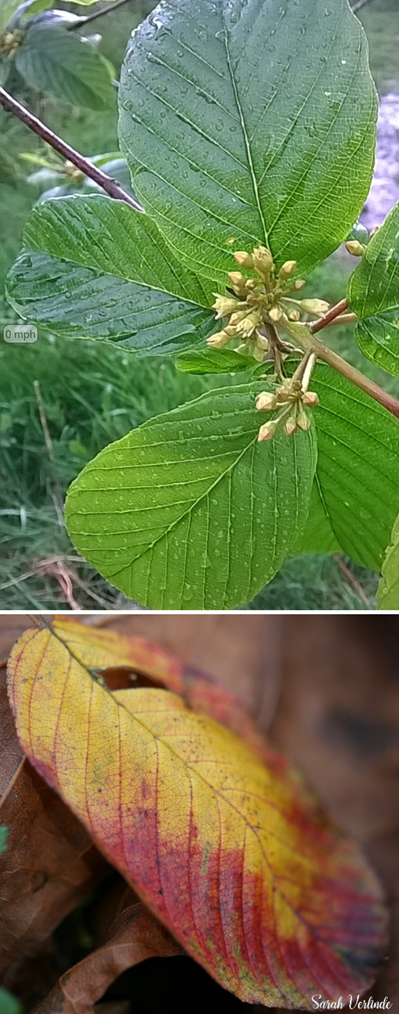Cascara
Frangula purshiana – Cascara/buckthorn
At a Glance:

- Family: Rhamnaceae
- Plant Type: small tree
- Distribution: Western North America, California to British Columbia, as far east as Montana
- Habitat: Forest edges and margins in low-mid elevations
- Height: 30 feet
- Flower/Fruits: clusters of small bell-shaped, pale green-yellow flowers with five petals. Berries are purple-black.
- Flowering Season: April – June
- Leaves: Oblong-obovate, meaning it is wider close to the tip of the leaf, rather than the base. Finely serrate margin. Deeply veined.
- Generation: Perennial
- Notable feature: When looking up at the tree from underneath, leaves appear to be spirally arranged (like a fan) around the tip. However, when looking at the branch up close, the leaves are actually alternately arranged, but still fanned out to capture sunlight efficiently.
- Notable feature: this tree is easy to identify during fall and winter because the leaf buds are not covered with scales, are paired, and look like a silhouette of angel wings.
Restoration and Conservation
Cascara provides fruits for birds to eat, and the flowers provide nectar for pollinators. In shrub form it can also provide shelter and thicket for birds to nest in. Cascara is a great native tree to plant in the city and suburbs. It’s small and well behaved, resistant to many pests, and is recommended to plant in small yards and safely below power lines.
Ethnobotany
This plant has been used in Western medicine and by Native Americans as a laxative. Native Americans would collect the bark and chew on it or make a tea with it. The main ingredient, anthraquinone, is very strong and bitter. Often the bark would be collected and aged before using it as a laxative to allow the chemicals to mellow out. It is so strong, that it can also be transferred through the skin, so gloves are recommended when handling it, or keep exposure times to a minimum. Animals that eat the berries, taste bitter themselves and can even pass along the chemical to the hunter through its meat. In the 1970s and 1980s five million pounds of dried Cascara bark from the PNW was processed by pharmaceutical companies.
Besides laxatives, the bark and dried berries was collected and used as a source of yellow dyes. The berry juice mixed with alum, results in a green dye.
On another fun note, Starbucks came out with their Cascara syrup in 2017. This is not to be confused with this Cascara tree or it’s laxative properties! Cascara means husk in Spanish, and in Starbuck’s case the syrup is derived from the coffee cherry/fruit (Coffea arabica) that surrounds the coffee bean. This is an excellent example of why common names should be avoided when talking about plants and why scientific names help clear up confusion when several plants share a common name.
References and Resources
- FEIS/USDA: https://www.fs.fed.us/database/feis/plants/shrub/frapur/all.html
- Seattle.gov: https://www.seattle.gov/trees/planting-and-care/trees-for-neighborhoods/past-plantings/cascara
- Starbucks: https://stories.starbucks.com/stories/2017/starbucks-cascara-latte
- WTU Image Herbarium: http://biology.burke.washington.edu/herbarium/imagecollection/taxon.php?Taxon=Frangula%20purshiana
This article was written by Sarah Verlinde. For questions regarding the UWB/CC Plant Tour, contact Sarah at severlin@uw.edu.